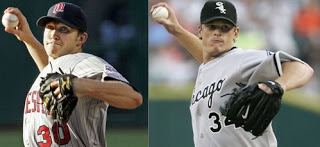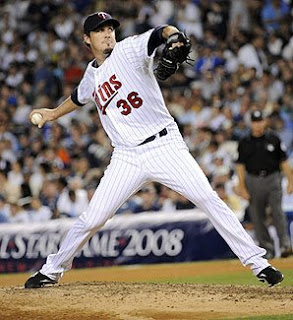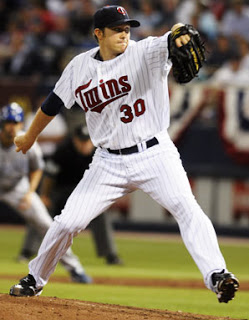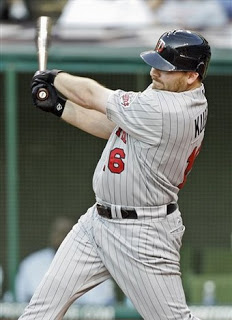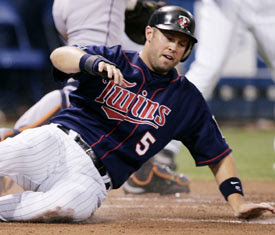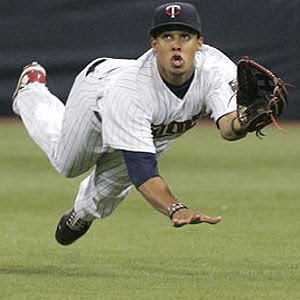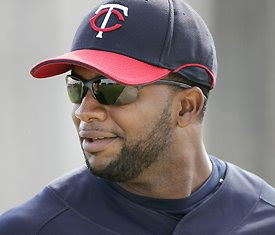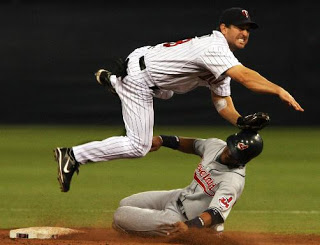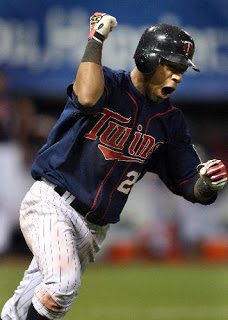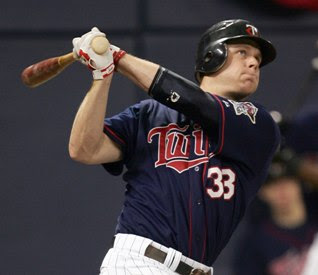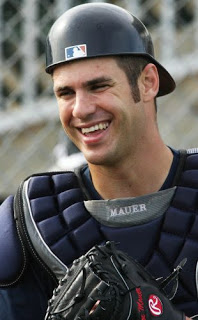NL Central
1. Chicago Cubs
It's true that the Brewers had a great run last year that should make us take them more seriously, but at the same time, they lost some of the principle movers in that run: C.C. Sabathia and Ben Sheets. In the meantime, the Cubs added last year's OPS leader in the AL, injury-addled and personally troubled Milton Bradley. Even if he only plays 120 or 130 games, he'll add to an already potent offense that includes Aramis Ramirez, Alfonso Soriano, and a decline-phase Derrek Lee. And don't forget the rotation includes Carlos Zambrano, Rich Harden, Ted Lilly and Ryan Dempster.
Player to watch: Sean Marshall, SP
(Marshall should be the 5th starter this year, winning the spot over Aaron Heilman. His peripherals aren't great, but 58 Ks in 65 innings last year looked good. He should be good for double-digit starts and a decent ERA.)
2. St. Louis Cardinals
The Brewers will be competitive for this second spot, but ultimately, I'm not convinced they have enough starting pitching to grab second place and what could be a possible wild-card spot. The Cards will have Chris Carpenter and Adam Wainwright back and any offense built around Albert Pujols isn't worth worrying about, even if Ryan Ludwick regresses from a breakout season in 2008. The Cards didn't do much in the offseason, but then again, neither did the Brewers.
Player to watch: Chris Perez, RP
(Now that Jason Isringhausen is gone, Perez seems likely to succeed him as the closer. He's a well-regarded relief prospect with a outstanding fastball, if not the greatest control. Don't expect a top ERA, but he should get saves, strikeouts, and a good ERA. Colby Ramus has an argument here, but I'd expect that breakout to come in another year.)
3. Milwaukee Brewers
The Brewers are a team I want to root for, but I'm just not sure that they are much better than a .500 or so team. Sure, they've got lots of hitters, from Ryan Braun to Prince Fielder to J.J. Hardy, but they have holes too, like Bill Hall and the frustratingly ineffective Rickie Weeks. The Brewers also have good young starters like Yovani Gallardo and Carlos Villenueva but they don't have a real ace and have mediocre leftovers like Jeff Suppan and Matt Bush to round out the rotation. More to the point, they don't have an overwhelming relief corps, with lots of big names (Trevor Hoffman, Braden Looper) but little substance.
Player to watch: Rickie Weeks, 2B
(Weeks has been around for a while and has produced plenty of lofty expectations, but he's yet to play a full season and has not shown his five-tools skills outside of good patience and speed. If he doesn't break out this year, he probably never is going to. Don't expect a high batting average (at least, not over .280), but he should hit with more power and show a good eye at the plate. )
4. Cincinnati Reds
Even though the Astros did well enough in the second half last year to finish above .500, I don't think they'll be repeating it this year. What's the difference between the team? The Reds have much better young talent in pitchers like Johnny Cueto and Homer Bailey and hitters like Jay Bruce and Joey Votto. Overall, they probably aren't ready to contend, but don't count out the Reds talent-wise.
Player to watch: Johnny Cueto, SP
(Cueto had a very exciting beginning of the year last year, striking out 10 in seven innings while giving up just one hit. Unfortunately, bad control and fly ball tendencies in a hitter's park worked against him over the year. I wouldn't expect a huge drop in ERA, but Cueto should strikeout plenty again and slowly get a hold of his control.)
5. Houston Astros
One word with the Astros: old. Mainstays, like Lance Berkman, are 33 and getting closer to inevitable decline. It is not so much that Berkman and Oswalt and other Astros veterans are going to fall off the cliff (though, clearly Miguel Tejeda has), but that there are no young stars to replace them. There are gaps all over the place on the Astros team -- from the starting rotation to catcher to center field to everyone in the bullpen outside of the closer, Jose Valverde, who is no guarantee himself.
Player to watch: Hunter Pence, OF
(Pence in some respects already had a breakout in his rookie campaign, but he arguably was below expectations last year, despite knocking out 25 home runs. Pence needs to learn the strike-zone better and learn to utilize his speed (11/21 on steals isn't good), things that he has a good chance to show over this next year.)
6. Pittsburgh Pirates
Even the most optimistic of pundits isn't likely to think the Pirates are going to do well this year. They've started to make the right changes, but it's certainly going to take some time. If nothing else, they have a good young starter in Paul Maholm, a good young closer in Matt Capps, and it is possible that given time, Andy LaRoche could show his skills with a full-time job.
Player to watch: Andy LaRoche, 3B
(It's about time LaRoche showed off his skills in the show, given his good numbers in the minors, where he produced a .294/.380/.517 overall. I'm not sure that LaRoche will ever produce that in the bigs, but he should be able to aproach a .265/.350/.450.)
NL East
1. Atlanta Braves
This pick may seem a little preposterous, but I feel as if the Braves have one shot this year with their current roster to make a run at the NL East and I'm not really overwhelmed by the Phillies or the Mets. Both those teams have holes, but the Braves have a potential outstanding rotation with Derek Lowe, Javier Vazquez and Jair Jurrgens, and their lineup includes Chipper Jones, Brain McCann and Kelly Johnson. I'm not impressed by moves like signing Garrett Anderson, but under the leadership of Bobby Cox, I have to think they can make it work.
Player to watch: Casey Kotchman, 1B
(Kotchman had been a disappointment overall for the Angels, considering that he hit .325/.401/.493 in the minors, but has managed only a .269/.336/.413 line in the majors. Kotchman will never be Prince Fielder, but I would certainly expect a better average, better discipline, and decent power in the future.)
2. Philadelphia Phillies
The Phillies have one of baseball's better lineups, despite losing Pat Burrell (sorry, but Raul Ibanez is not the best replacement), but their pitching worries me and the defending champs don't have me convinced. Yes, they have Brad Lidge and Cole Hamels, who are both incredible, but otherwise, I'm not impressed by Joe Blanton, J.C. Romero, and Brett Myers. And I'm pretty sure that eventually, Jamie Moyer will truly show his age. I just don't think he's the second coming of Hoyt Wilhelm. They'll be good with a lineup including MVP candidates like Chase Utley, but not good enough.
Player to watch: Jayson Werth, OF
(This is more a less a cop-out, since Werth hit .273/.363/.498 in 418 at-bats last year. But, the Phillies don't have a lot of good breakout candidates and Werth hasn't had success for a full year. Given a full year, Werth should be able to hit with power and patience again, and possible approach 30 home runs and 100 RBI. Apologies to Terry Tiffee fans everywhere.)
3. New York Mets
The Mets look good on paper and probably have an excellent chance to win the East, but given what has happened in the past, it is awfully hard to ignore the difference between two halves. If the Mets are a schizophrenic team again, then it will be another hard road to the playoffs. And no, I don't think K-Rod makes much of a difference, since he was underwhelming last year despite his guady save stats. I would expect disappointment again.
Player to watch: Jon Niese, SP
(Niese didn't have a good September appearance last year (7.07 ERA, 14 innings), but he's done well enough in the minors (3.04 ERA in the minors last year) that he should be able to have a strong rookie season with a solid K-rate. Otherwise, the Mets don't have any other clear candidates to break out yet.)
4. Florida Marlins
Don't get me wrong; I like the Marlins. Enough so, that as a team filled with young talent, I'd like to have them as a surprise pick. Their rotation is quite impressive: Ricky Nolasco (who seemed to have a great season that no one noticed), Chris Volstad, Josh Johnson, and Anibal Sanchez. But they don't really have a stable bullpen and outside of Hanley Ramirez and Dan Uggla, they don't have any established hitters, which was only exacerbated by the offseason trades of Mike Jacobs and Josh Willingham. Still, don't be surprised if they exceed expectations.
Player to watch: Jeremy Hermida, OF
(Hermida was long a top prospect who had a memorable first big-league at-bat and who looked poised to breakout after his 2007 season. However, he disappointed last year, ending up with a .249/.323/.406 line. Hermida is still only 24, has shown solid patience and power in the past and given one more opportunity, he may surprise.)
5. Washington Nationals
The Nats, after their offseason scandal ending with the firing of Jose Rijo and the resignation of Jim Bowden, seem like the most hopeless team in baseball, competing with the Padres and Pirates. Granted, they signed Adam Dunn, but I'm not sure he'll change too much since his on-base skills and powers may be of less in a lineup with little protection. It seems like it may simply be a question of how many games they'll lose. Ultimately, they seem like the hoarding ground for drama queens and headcases like Scott Olsen, Elijah Dukes, Daniel Cabrera, and others. If nothing else, maybe that will add some intrigue?
Player to watch: Elijah Dukes, OF
(He's clearly has some issues, but as many of those as he has, he is also oozing with talent. Speed, power, and patience are all there for Dukes if he can put the package together. He hit .264/.386/.478 in 276 at-bats, so it seems entirely possible that he can display star talent over the year.)
NL West
1. Arizona Diamondbacks
I'm making this pick because I'm fairly confident in the natural growth of Arizona's top young hitters, including Chris Young, Justin Upton, Stephen Drew, Mark Reynolds and Conor Jackson. Additionally, they have some young pitching talent in Yusmeiro Petit and Max Scherzer to go with the phenomenal 1-2 punch of Brandon Webb and Dan Haren. And while the relief corps isn't the best, arms like Tony Pena and Jon Rauch should make a successful one.
Player to watch: Chris Young, CF
(I think it would be easy to pick Justin Upton, since he's almost sure to impress, but Young seems more appropriate. He's shown plenty of talent in his two years with Diamondbacks, but he has yet to show the same combination of power, speed, and patience he showed in the minors. His BA/BIP of .300 (actually average of .248) says that he'll some luck to increase his average, but I think he's a solid bet to make a jump this year.)
2. Los Angeles Dodgers
I like that the Dodgers made some solid offseason moves, signing Manny and Orlando Hudson. Overall, that gives the Dodgers a solid lineup, adding them to the likes of Matt Kemp, James Loney, and Russell Martin. However, I'm not as confident about the pitching. Chad Billingsley is an ace at this point and Clayton Kershaw has plenty of talent, but they lost their second best starter (Derek Lowe) and a successful closer in Takashi Saito and are left with options like Jeff Weaver and Randy Wolf.
Player to watch: Matt Kemp, OF
(Kemp was pretty impressive last year, combining 35 steals with 18 home runs and 38 doubles. Somehow, it wasn't noticed and Kemp was considered by some to be a disappointment. Thus, he's still a breakout candidate to me and given the talent he's shown, I think Kemp can hit 20-25 home runs, with a .300 average and 40 steals. Sounds like a stellar talent.)
3. San Francisco Giants
The Giants get this ranking almost purely on the basis of their standout rotation. They have Randy Johnson, who had quite the eye-opening season for a pitcher his age last year (173 Ks, 184 innings), joining Cy Young winner Tim Lincecum and Matt Cain in a pitcher's park. Of course, their only other big signing was Edgar Renteria, who was one of the worst everyday players in baseball last year. The Giants won't hit at all, but they'll pitch enough to be in the middle of the pack in the weak NL West.
Player to watch: Matt Cain, SP
(Let me clarify: this is mostly in response to those who think wins are the best way of statistically evaluating a pitcher's contribution to his team. That luck should change at least enough to a "breakout," as he should be able to produce double-digit wins with his talent. Otherwise, Cain can improve on his ERA by reducing a walk-rate that has not moved much at all in his first three full seasons. If he can do that, he'll probably get more strikeouts and we'll see a season representing what we've expected from him since he came up and first tantalized the league with his talent in 2005.)
4. Colorado Rockies
The Rockies certainly have some good players--young pitchers like Ubaldo Jimenez and Franklin Morales and hitters like Chris Iannetta and Troy Tulowitzki. They also have mainstays like Garrett Atkins and Brad Hawpe, as well as ancient Rockie Todd Helton, but they really don't have enough pitching or hitting overall to have much success. Despite their success in the 2007 season, after trading their best player Matt Holliday, they appear to be in rebuilding mode yet again.
Player to watch: Chris Iannetta, C
(Iannetta seems poised for a big season from the catcher's position, as he produced a solid .264/.390/.505 line in 388 at-bats, showing great plate discipline and plenty of power for the position. He's only hit .249 so far in the bigs, but he was a .303/.407/.508 hitter in the minors, so it seems reasonable that his average will come up as well this year.)
5. San Diego Padres
I've already tagged them as one of baseball hopeless teams, so it seems clear I do not think much of them. Perhaps scanning the roster will show you why; there just isn't much there to like. Adrian Gonzalez is a very good hitter and would surely look a lot better if he wasn't in the offense-suffocating environment of Petco Park. Of course, I shouldn't underestimate them -- after all, they have David Eckstein on their team and you know all the intangibles he has. Can't measure those with stats.
Player to watch: Kevin Kouzmanoff, 3B
(Kouzmanoff should be a DH in the American League, and not just because he's a terrible fielder but also because he was a .292/.329/.473 hitter on road and a .226/.268/.390 hitter at Petco. Forgetting those issues, Kouzmanoff was a .332/.393/.556 in the minors. As with many of these breakout candidates, simply having a good minor league track record doesn't necessarily mean major-league success, so he could end up a bust. However, given that record, it is reasonably to believe that he'll breakout this year. Anyways, are there many other candidates on the Padres you can point to?)

